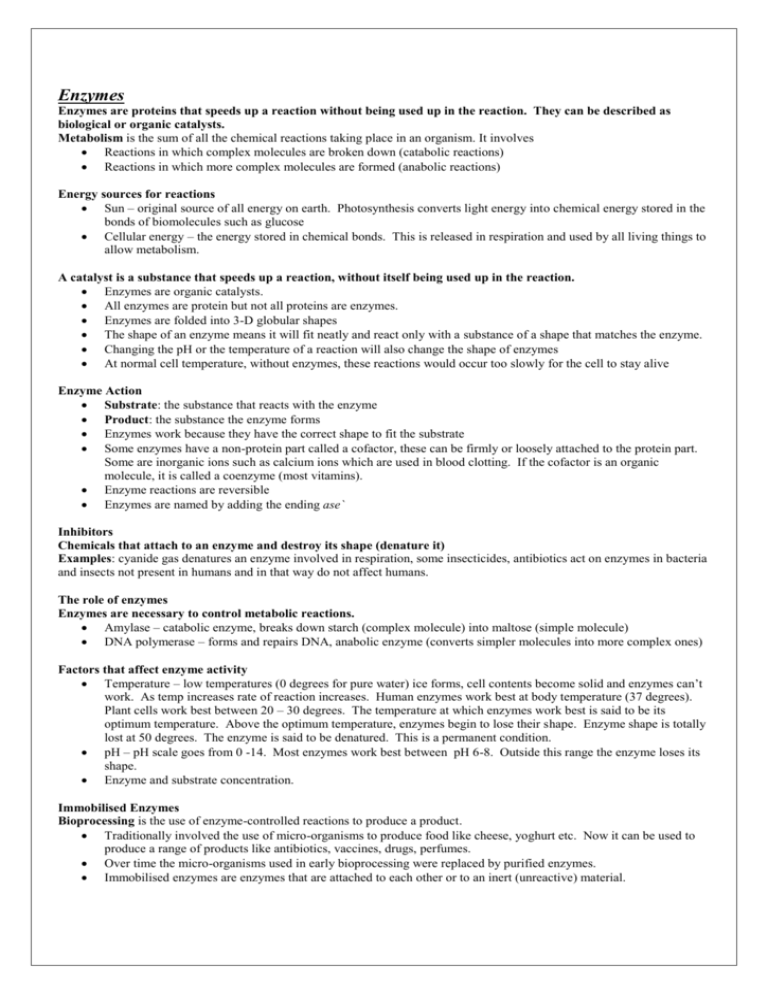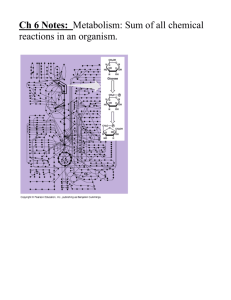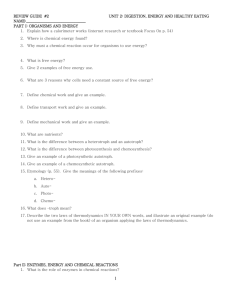Enzymes - cbbiology
advertisement

Enzymes Enzymes are proteins that speeds up a reaction without being used up in the reaction. They can be described as biological or organic catalysts. Metabolism is the sum of all the chemical reactions taking place in an organism. It involves Reactions in which complex molecules are broken down (catabolic reactions) Reactions in which more complex molecules are formed (anabolic reactions) Energy sources for reactions Sun – original source of all energy on earth. Photosynthesis converts light energy into chemical energy stored in the bonds of biomolecules such as glucose Cellular energy – the energy stored in chemical bonds. This is released in respiration and used by all living things to allow metabolism. A catalyst is a substance that speeds up a reaction, without itself being used up in the reaction. Enzymes are organic catalysts. All enzymes are protein but not all proteins are enzymes. Enzymes are folded into 3-D globular shapes The shape of an enzyme means it will fit neatly and react only with a substance of a shape that matches the enzyme. Changing the pH or the temperature of a reaction will also change the shape of enzymes At normal cell temperature, without enzymes, these reactions would occur too slowly for the cell to stay alive Enzyme Action Substrate: the substance that reacts with the enzyme Product: the substance the enzyme forms Enzymes work because they have the correct shape to fit the substrate Some enzymes have a non-protein part called a cofactor, these can be firmly or loosely attached to the protein part. Some are inorganic ions such as calcium ions which are used in blood clotting. If the cofactor is an organic molecule, it is called a coenzyme (most vitamins). Enzyme reactions are reversible Enzymes are named by adding the ending ase` Inhibitors Chemicals that attach to an enzyme and destroy its shape (denature it) Examples: cyanide gas denatures an enzyme involved in respiration, some insecticides, antibiotics act on enzymes in bacteria and insects not present in humans and in that way do not affect humans. The role of enzymes Enzymes are necessary to control metabolic reactions. Amylase – catabolic enzyme, breaks down starch (complex molecule) into maltose (simple molecule) DNA polymerase – forms and repairs DNA, anabolic enzyme (converts simpler molecules into more complex ones) Factors that affect enzyme activity Temperature – low temperatures (0 degrees for pure water) ice forms, cell contents become solid and enzymes can’t work. As temp increases rate of reaction increases. Human enzymes work best at body temperature (37 degrees). Plant cells work best between 20 – 30 degrees. The temperature at which enzymes work best is said to be its optimum temperature. Above the optimum temperature, enzymes begin to lose their shape. Enzyme shape is totally lost at 50 degrees. The enzyme is said to be denatured. This is a permanent condition. pH – pH scale goes from 0 -14. Most enzymes work best between pH 6-8. Outside this range the enzyme loses its shape. Enzyme and substrate concentration. Immobilised Enzymes Bioprocessing is the use of enzyme-controlled reactions to produce a product. Traditionally involved the use of micro-organisms to produce food like cheese, yoghurt etc. Now it can be used to produce a range of products like antibiotics, vaccines, drugs, perfumes. Over time the micro-organisms used in early bioprocessing were replaced by purified enzymes. Immobilised enzymes are enzymes that are attached to each other or to an inert (unreactive) material. Methods of immobilising enzymes Physical methods: (a) adsorption – enzymes are physically attached to inactive supports such as glass beads, ceramics, cellulose particles or artificial polymers, (b) trapping enzymes in a gel: sodium alginate gel is the most common, substrate can enter the gel and products may leave it, (c) enclosed in a membrane. Chemical methods: (a) bonded to a support or (b) bonded to each other. Advantages of immobilised enzymes Efficiency of enzyme is not affected Immobilised enzymes can be recovered from the reaction vessel at the end of the process Immobilised enzymes can be reused Immobilising the enzyme increases its stability, reducing the amount of enzyme needed Uses of immobilised enzymes An immobilised enzyme called glucose isomerase converts glucose to sweeter tasting fructose, which is used to sweeten soft drinks. Lactase converts lactose into sweeter tasting sugars glucose and galactose. These are used to replace condensed milk in the manufacture of soft toffee and caramel. Enzymes (advanced study) and Energy Carriers (Higher Level only) Active site: the part of an enzyme that combines with the substrate. It is a depression or pocket in the surface of the enzyme Enzymes have 3D complex shapes as has the active site Many enzymes are made up of two or more globular sections, called domains, joined together When the substrate enters the active site it causes (or induces) it to change shape slightly, the active site then fits precisely around the substrate → induced fit model of enzyme action Mechanism of enzyme action – the induced fit model 1. The substrate combines with the active site of the enzyme 2. The active site changes shape slightly 3. Substrate and enzyme form an enzyme-substrate complex. The bonds in the substrate are altered so that the substrate changes into the product(s) 4. The products leave the active site. Active site can now return to it’s original shape and accept a new substrate molecule. This process is very fast, in some enzymes, it occurs 1000 times every second. A small amount of enzyme can process a large number of substrate molecules in a short space of time. Enzyme Specificity Most enzymes are specific → they will only react with one particular substrate. Each active site will only fit a single substrate. Active site is particularly sensitive to pH, if pH is unsuitable the active site changes shape and will no longer accept a substrate molecule. Most human enzymes work best between pH 6 – 8, this is their optimum pH Enzymes are very sensitive to temperature changes. An increase in temperature causes increased molecular movement, the substrate molecules collide more frequently with enzymes. This means reaction rates rise as temperatures rise. Plant enzymes work best between 20 – 30 degrees. Human enzymes work best at 37 degrees. These temperatures are referred to as their optimum temperatures. Denaturation If temperature rises too much an enzyme will begin to lose its shape. When an enzyme loses its shape completely it is said to be denatured. Most proteins are denatured above 40 degrees. Energy Carriers ATP is important in trapping and transferring energy in processes like photosynthesis and respiration NAD+ (respiration) and NADP+ (photosynthesis) trap and transfer energy in the form of high-energy electrons ADP and ATP ADP: Adenosine DiPhosphate, found in cells of all living organisms. It is made from the base adenine, a 5-carbon sugar called ribose, and two phosphate groups. The bond between the two phosphate groups is an unstable bond. ADP can be thought of as a low energy molecule. ATP: Adenosine TriPhosphate: if a phosphate group is added to ADP, ATP is formed. The process of adding a phosphate group is called phosphorylation: (ADP + energy + P → ATP). ATP stores energy, it is equivalent to a fully charged battery, whereas ADP can be thought of as only a partially charged battery. ATP can’t store energy for long so this energy must be used by the body immediately. When ATP is broken down it releases ADP, a phosphate and energy. This energy is used to carry out most of the reactions in cells (ATP → ADP + P + energy). NADP+ and NADPH NADP: Nicotinamide Adenine Dinucleotide Phosphate is a low energy molecule involved in photosynthesis A hydrogen atom (H) consists of a proton (H+) and an electron NADP can accept a pair of high-energy electrons and a H+ to form NADPH (NADP+) + (2 electrons) + H+ → NADPH low energy high energy high energy NADPH is a very high-energy molecule, it is an electron carrier and a hydrogen carrier. When NADPH breaks down it releases NADP+, 2 electrons and a H+. NAD+ : Nicotinamide Adenine Dinucleotide is used in respiration as an equivalent low energy molecule to NADP+. In the same way, respiration uses NADH as an equivalent high-energy molecule to NADPH.







